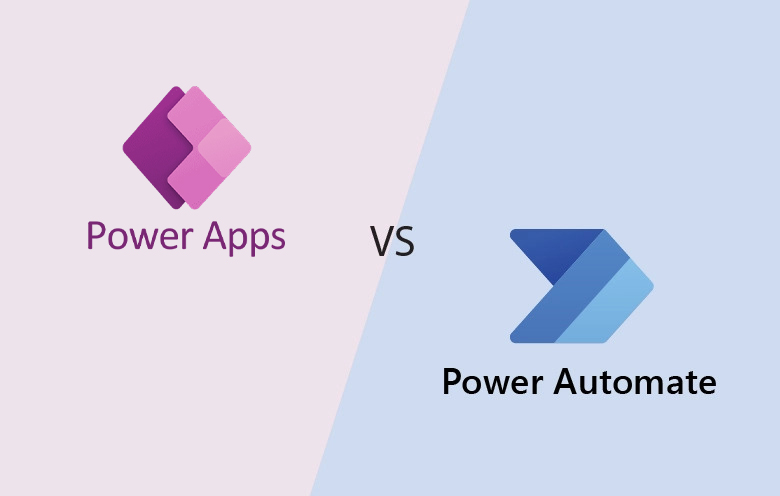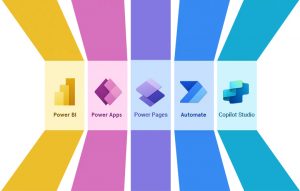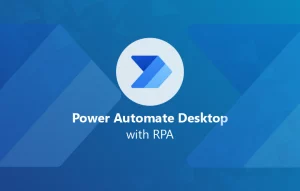You know that in today’s rapidly evolving business landscape, staying competitive requires streamlining workflows and enhancing productivity. Fortunately, Microsoft offers two powerful tools, Power Apps and Power Automate, to help you achieve these goals.
Although both tools are connected and built on a common foundation, they perform different functions and are better suited to specific tasks. By leveraging Power Apps and Power Automate, you can automate and streamline your workflows to address the current challenges of the business world.
What is Power Apps and how does it work
Power Apps is a low-code development platform that allows users to develop custom apps for specific business needs without extensive coding knowledge. By creating custom business apps with Power Apps, you can revolutionize your business operations. These custom apps can connect to various data sources, such as SharePoint, Excel and Dynamics 365. You can also build custom workflows that automate processes and improve productivity. Power Apps is an ideal tool for creating custom forms and interfaces on any device. This makes it easier for employees to complete tasks from anywhere.
The benefits of Power Apps include:
- Automates repetitive tasks and workflows, increasing efficiency and productivity.
- Integrates different applications and systems, streamlining communication and reducing errors.
- Provides real-time data and analytics, allowing quick decision-making and better business insights.
A few companies that use Power Apps –
1. Chevron: Chevron, a multinational energy corporation, uses Power Apps to build apps that track their inventory of tools and equipment, as well as monitor and manage environmental compliance.
2. Hewlett Packard Enterprise (HPE): HPE, a global technology company, uses Power Apps to create apps that help their sales team manage customer accounts, track sales activities and collaborate more effectively.
3. Siemens: Siemens, a multinational conglomerate, uses Power Apps to build apps that support their manufacturing and industrial operations, including apps to manage maintenance schedules, monitor production line performance and track inventory levels.
4. Unilever: Unilever, a global consumer goods company, uses Power Apps to build apps that help their employees manage expenses, track project progress and automate manual processes.
What is Power Automate and how does it work
Power Automate (formerly known as Microsoft Flow) is a workflow automation tool that allows users to create automated workflows between apps and services. With Power Automate capabilities, you can automate tasks and processes, such as sending notifications, moving data, and syncing files between different applications. It also has a wide range of pre-built templates and connectors that allow you to easily integrate with popular apps and services, such as Microsoft Teams, Outlook and SharePoint.
The use of Power Automate has numerous advantages:
- Workflow automation using Power Automate minimizes repetitive tasks and simplifies processes, allowing staff to allocate more time towards intricate and innovative work.
- Data integration with Power Automate facilitates the integration of various applications and systems, leading to streamlined communication and reduced errors.
- Provides real-time data and analytics, allowing quick decision-making and better business insights.
A few companies that use Power Automate –
- The Coca-Cola Company – The Coca-Cola Company has implemented Power Automate to automate its employee onboarding process. The company uses Power Automate to manage the employee onboarding process, from sending offer letters to setting up new hires in the company’s HR systems.
- Ikea – This furniture giant uses Power Automate to automate its human resource processes, including employee onboarding, offboarding and performance management.
- Air Canada – This airline uses Power Automate to automate its travel authorization and reimbursement processes, helping to simplify and speed up these processes for its employees.
- Telstra – Telstra is Australia’s leading telecommunications company. They use Power Automate to automate their internal processes and workflows, such as employee onboarding and offboarding, approval workflows, and data synchronization between different systems. By using Power Automate, Telstra has been able to reduce manual errors, increase efficiency, and improve collaboration between teams.
What are the key differences between Power Apps and Power Automate?
Power Apps and Power Automate are both products within the Power Platform suite of low-code tools from Microsoft. However, they serve different purposes and have different features. Here are some of the main differences between Power Apps and Power Automate:
Modifications and improvements:
One of the most notable differences between Power Apps and Power Automate lies in their respective procedures for modifications and improvements. Power Apps apps can be updated within the Power Apps environment, with any modifications taking effect immediately.
Power Automate, involves an interface called Flow, which allows users to create automated workflows between applications and services. While this may add an extra step to the modification process, it also means users have the flexibility to create more complex and customizable workflows. Therefore, the choice between Power Apps and Power Automate ultimately depends on the specific needs of a business and the tasks that need to be automated.
Adaptability and versatility:
Power Apps is more adaptable and flexible than Power Automate. This is because you can access it from any device with a web browser, but you need a desktop PC to access Power Automate. Power Apps is also compatible with other Microsoft programs and can be used on multiple platforms, including Power BI, Dynamics 365 and SharePoint.
For example, Power Apps can create custom data entry forms, but Power Automate workflows do not support customized forms. However, the Power Automate workflow integration is only available on SharePoint.
Both tools are highly versatile and can solve various business challenges by building custom applications or automating workflows.
Click here to explore the top 9 Power Automate use cases to adopt in 2023
Working in close coordination and independently:
The primary difference between Power Apps and Power Automate lies in their usage. Typically, Power Apps apps are interconnected with other Microsoft products like Dynamics 365 and SharePoint.
On the contrary, Microsoft products are not required to use Power Automate workflows. If you require a platform that can be implemented independently of other Microsoft products, then Power Automate is the most suitable option.
Membership offers:
You must consider your organization’s specific business requirements while choosing Power Apps or Power Automate for your company. Power Apps development is ideal for businesses that need to create custom apps with a user-friendly interface for accessing data and performing business functions. It can streamline data entry, reduce paperwork and improve productivity.
On the other hand, Power Automate is better suited to businesses that require workflow and process automation. This is to reduce manual processes, streamline data transfer and increase efficiency.
In some cases, a business may require both Power Apps and Power Automate to create a more comprehensive automation solution. For example, a company can use Power Apps to create a custom app that collects data from its employees. Additionally, they can also use Power Automate to automate the process of transferring that data to another system. This can trigger a specific action based on that data.
Ultimately, the choice between Power Apps and Power Automate depends on your organization’s specific workplace requirements and the processes you want to automate. Both tools offer a range of features and integrations that can help businesses streamline their operations, reduce manual processes and improve efficiency.
How can Softweb help you leverage these tools for best business outcomes?
Both Power Apps and Power Automate can bring significant benefits to your business but implementing them effectively requires expertise and experience. The best way for you to ensure smooth and effective implementation or integration is to get assistance from an expert Microsoft consulting company. That’s where Softweb Solutions comes in.
As a Microsoft Gold Partner, Softweb has the skills and knowledge necessary to help you leverage the Power Platform to achieve your business goals. Our experts can provide guidance and support throughout the entire process, from planning and development to deployment and maintenance.
In addition, we have certified professionals to help you integrate Power Apps and Power Automate with other Microsoft tools and applications, such as Dynamics 365, SharePoint and Power BI. This allows you to create a comprehensive automation solution that meets all your business needs.










